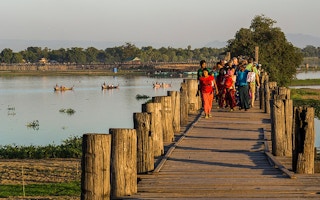Sitting in a shop on the riverfront in Mandalay just last week, Win Nyunt assessed whether it was safe to hide a tonne of illegally logged teak in a nearby monastery at midnight.
“If I put the logs in the monastery it is safer, but I don’t like to do that because I am a religious guy. I don’t want to mix business with religion,” the teak trader told Mongabay about his work in Myanmar’s second largest city.
Normally Win Nyunt would keep the 2,200 pounds of Burmese hardwood logs at his home, but needed to make an exception with his latest boatload because of increased police activity.
“I have never seen this kind of restriction in my life, this is the worst,” said Win Nyunt.
There’s good reason for the pressure.
Myanmar has the third highest rate of deforestation in the world. As part of an attempt to arrest the catastrophic annual forest loss of 1.8 per cent, the country is in the midst of a logging ban set to end next year.
Shortly after Aung San Suu Kyi’s National League for Democracy (NLD) assumed power in Myanmar in April 2016, a temporary ban on all logging was brought into force.
For the duration of the ban, which runs into April 2017, any demand for wood is expected to be met through stockpiled wood controlled by the government’s logging entity Myanmar Timber Enterprise (MTE).
The ban is seen as a way to not only protect Myanmar’s forests but to save lives. In 2012 the UN ranked Myanmar as the Asian Pacific country most at risk from natural disasters – including floods and landslides which are exacerbated by deforestation.
The country lost 546,000 hectares of forest on average each year between 2010 and 2015, the UN’s Food and Agriculture Organisation (FAO) says in their most recent assessment. Between 1990 and 2015, nearly 15 million hectares of forest and wooded land disappeared.
“
All of the good teak from the forest is gone now, we just have bush.
Maung Maung U, environmentalist, Sein Yaung Soe
Prized trees
Officials are stretched thin in their attempts to stop illegal logging across the many miles of Myanmar’s rugged terrain – some of which is only accessible by motorbike or hiking. Riverside cities that serve as hubs to move illegally logged products are somewhat easier pickings for targeted busts.
The vast majority of timber and logs are on their way to China.
Maung Maung U, an environmentalist with the civil society organisation Sein Yaung Soe, says the issue of deforestation is particularly severe in Mandalay.
“Before 1988, 52 per cent of the Mandalay area was forest, now it is just around 20 per cent,” he said.
Vast numbers of trees have been cut down and exported, often to China, since Myanmar began emerging from economic isolation in 2011. Teak is the most common target as well as Burmese rosewood – a popular material for high-end furniture. Rosewood can go for $50,000 per cubic meter on the open market in China.
“All of the good teak from the forest is gone now, we just have bush,” said Maung Maung U. “The country is overrun by bush.”
A particularly decisive year was 2014. In April 2014, the Burmese government banned the export of all raw timber but illegal loggers continued to export huge amounts to China.
Last month Myanmar’s minister for natural resources and conservation, U Ohn Win, said that in 2014 “more than one million cubic tons of timber was illegally exported to China’s Yunnan Province from the far north of Myanmar” adding that it accounted for 95 percent of all timber exports.
But it is not only export that has decreased Myanmar’s forests but also domestic use in a country that is heavily dependent on wood as a natural resource.
“Every wood is used for everything,” said Maung Maung U, citing timber’s use in home building, furniture and making fires for cooking on. “Even our chairs are made from bamboo.”
This story was published with permission from Mongabay.com. Read the full story.










